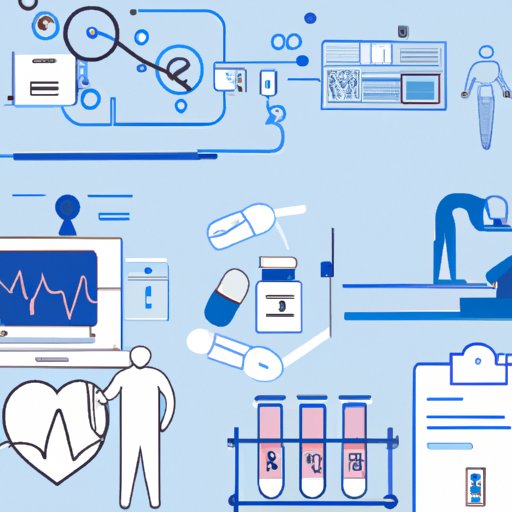Introduction
Health Sciences STEM (Science, Technology, Engineering, and Mathematics) combines the knowledge and skills from multiple disciplines to provide a comprehensive approach to addressing health-related issues. This field has become increasingly important as advancements in technology have made it possible for medical professionals to diagnose, treat, and manage patients more effectively. By leveraging cutting-edge tools and techniques, health sciences STEM can help to improve patient outcomes, reduce costs, and increase access to quality healthcare.
A Profile of a Health Sciences STEM Professional
In order to be successful in a health sciences STEM career, individuals must possess a strong foundation in mathematics, computer science, and engineering. They must also understand biology, chemistry, and physics, and have an appreciation for the social and environmental aspects of health. Additionally, they need to be able to think critically and solve complex problems. The ability to collaborate with other professionals is also essential.
Individuals who pursue a career in health sciences STEM typically start out by earning a bachelor’s degree in a related field. From there, they may choose to specialize in a particular area, such as biotechnology or medical informatics. With additional education and experience, they may qualify for advanced positions, such as medical scientists or biomedical engineers.
Health sciences STEM professionals often work in a variety of settings, including hospitals, research laboratories, universities, and pharmaceutical companies. They are responsible for developing new treatments and technologies, conducting research, and analyzing data. In addition, they may be involved in the design, implementation, and evaluation of programs that promote public health.

Examining the Intersection of Health and Technology
The use of technology in health sciences STEM is essential in order to facilitate the diagnosis and treatment of diseases. For example, medical imaging devices, such as X-ray machines, CT scanners, and MRI machines, allow for the visualization of internal organs and tissues. Robotics and automation are also being used to automate certain tasks, such as drug dispensing and surgical procedures.
In addition, artificial intelligence and machine learning are being employed to analyze large amounts of data and identify patterns in order to make predictions about disease progression and treatment outcomes. Wearable technologies and digital health platforms are being used to monitor patient health and provide personalized care. Finally, 3D printing and virtual reality are being used to create models of organs and tissues for educational and research purposes.
An Overview of the Latest Developments in Health Sciences STEM
Recent advances in health sciences STEM have had a profound impact on the diagnosis and treatment of diseases. For instance, gene editing techniques, such as CRISPR, have enabled researchers to modify genes with precision and accuracy. In addition, the development of personalized medicine has allowed for the creation of treatments tailored to an individual’s genetic makeup.
“We are entering an era where we can customize therapies based on a person’s unique genetic makeup,” says Dr. Eric Topol, director of the Scripps Translational Science Institute. “This will revolutionize the way we diagnose and treat diseases.”
Other advancements include the development of lab-grown organs, which could potentially be used for transplantation, and the use of nanotechnology to deliver drugs directly to cancer cells. In addition, researchers are exploring the use of stem cell therapies to regenerate damaged tissues and organs.

The Role of Health Sciences STEM in Healthcare Delivery
Health sciences STEM is playing an increasingly important role in healthcare delivery. By leveraging the latest technologies, healthcare providers are able to improve access to care, enhance the quality of care, and reduce costs. For example, telemedicine enables patients to receive care from a distance, while electronic health records allow for the secure storage and exchange of patient information.
In addition, health sciences STEM is being used to develop predictive algorithms that can alert clinicians to potential problems before they occur. This can help to prevent costly errors and ensure that patients receive timely and appropriate care.
Investigating the Impact of Health Sciences STEM on Society
The impact of health sciences STEM goes beyond the realm of healthcare delivery. It is also having a significant effect on society as a whole. For example, the use of automated systems to diagnose and treat diseases has enabled healthcare providers to reach more people in less time. In addition, the development of new treatments and technologies has improved the quality of life for many individuals.
The economic impact of health sciences STEM is also substantial. According to a report by the World Economic Forum, the global market for health-related technologies is expected to reach $1.2 trillion by 2025. This growth is creating new jobs and helping to drive economic development.

Exploring the Future of Health Sciences STEM
The future of health sciences STEM looks very promising. As technological advancements continue, healthcare providers will be able to leverage powerful tools and techniques to diagnose and treat diseases more effectively. Additionally, emerging trends such as personalized medicine, artificial intelligence, and robotics will likely revolutionize the way healthcare is delivered.
Finally, the development of new technologies and protocols will enable healthcare providers to reach more people in less time and at lower costs. This could potentially lead to more equitable access to care and improved outcomes for all.
Conclusion
Health sciences STEM is an exciting and rapidly growing field that is transforming the way healthcare is delivered. By leveraging the latest technologies, healthcare providers are able to diagnose and treat diseases more effectively, improve access to care, and reduce costs. As technological advancements continue, health sciences STEM will continue to play an increasingly important role in healthcare delivery and society as a whole.
(Note: Is this article not meeting your expectations? Do you have knowledge or insights to share? Unlock new opportunities and expand your reach by joining our authors team. Click Registration to join us and share your expertise with our readers.)
